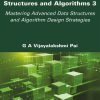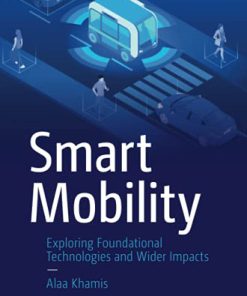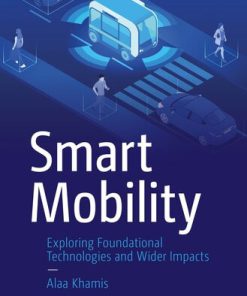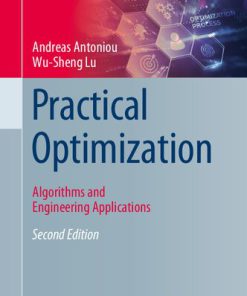Optimization Algorithms AI techniques for design planning and control problems 1st edition by Alaa Khamis 163343883X 9781633438835
$50.00 Original price was: $50.00.$25.00Current price is: $25.00.
Optimization Algorithms AI techniques for design planning and control problems 1st edition by Alaa Khamis – Ebook PDF Instant Download/Delivery: 163343883X, 9781633438835
Full download Optimization Algorithms AI techniques for design planning and control problems 1st edition after payment
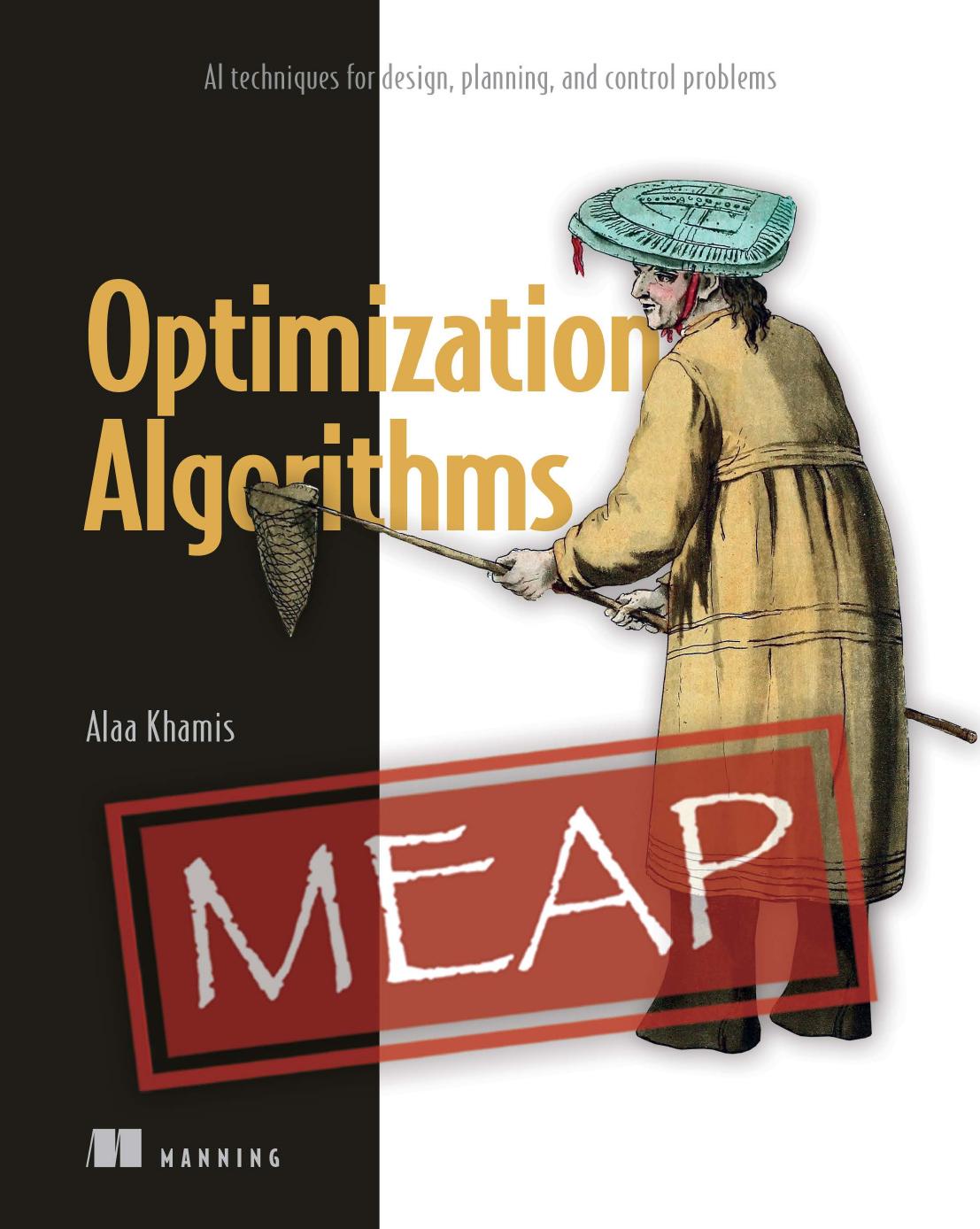
Product details:
ISBN 10: 163343883X
ISBN 13: 9781633438835
Author: Alaa Khamis
Solve design, planning, and control problems using modern AI techniques. Optimization problems are everywhere in daily life. What’s the fastest route from one place to another? How do you calculate the optimal price for a product? How should you plant crops, allocate resources, and schedule surgeries? Optimization Algorithms introduces the AI algorithms that can solve these complex and poorly-structured problems. In Optimization Algorithms: AI techniques for design, planning, and control problems you will learn: • The core concepts of search and optimization • Deterministic and stochastic optimization techniques • Graph search algorithms • Trajectory-based optimization algorithms • Evolutionary computing algorithms • Swarm intelligence algorithms • Machine learning methods for search and optimization problems • Efficient trade-offs between search space exploration and exploitation • State-of-the-art Python libraries for search and optimization Inside this comprehensive guide, you’ll find a wide range of optimization methods, from deterministic search algorithms to stochastic derivative-free metaheuristic algorithms and machine learning methods. Don’t worry—there’s no complex mathematical notation. You’ll learn through in-depth case studies that cut through academic complexity to demonstrate how each algorithm works in the real world. Plus, get hands-on experience with practical exercises to optimize and scale the performance of each algorithm. About the technology Every time you call for a rideshare, order food delivery, book a flight, or schedule a hospital appointment, an algorithm works behind the scenes to find the optimal result. Blending modern AI methods with classical search and optimization techniques can deliver incredible results, especially for the messy problems you encounter in the real world. This book shows you how. About the book Optimization Algorithms explains in clear language how optimization algorithms work and what you can do with them. This engaging book goes beyond toy examples, presenting detailed scenarios that use actual industry data and cutting-edge AI techniques. You will learn how to apply modern optimization algorithms to real-world problems like pricing products, matching supply with demand, balancing assembly lines, tuning parameters, coordinating mobile networks, and cracking smart mobility challenges. What’s inside • Graph search algorithms • Metaheuristic algorithms • Machine learning methods • State-of-the-art Python libraries for optimization • Efficient trade-offs between search space exploration and exploitation About the reader Requires intermediate Python and machine learning skills. About the author Dr. Alaa Khamis is an AI and smart mobility technical leader at General Motors and a lecturer at the University of Toronto. The technical editor on this book was Frances Buontempo. Table of Contents PART 1 1 Introduction to search and optimization 2 A deeper look at search and optimization 3 Blind search algorithms 4 Informed search algorithms PART 2 5 Simulated annealing 6 Tabu search PART 3 7 Genetic algorithms 8 Genetic algorithm variants PART 4 9 Particle swarm optimization 10 Other swarm intelligence algorithms to explore PART 5 11 Supervised and unsupervised learning 12 Reinforcement learning Appendix A Appendix B Appendix C
Optimization Algorithms AI techniques for design planning and control problems 1st Table of contents:
Part 1. Deterministic search algorithms
1 Introduction to search and optimization
1.1 Why care about search and optimization?
1.2 Going from toy problems to the real world
1.3 Basic ingredients of optimization problems
1.3.1 Decision variables
1.3.2 Objective functions
1.3.3 Constraints
1.4 Well-structured problems vs. ill-structured problems
1.4.1 Well-structured problems
1.4.2 Ill-structured problems
1.4.3 WSP, but ISP in practice
1.5 Search algorithms and the search dilemma
Summary
2 A deeper look at search and optimization
2.1 Classifying optimization problems
2.1.1 Number and type of decision variables
2.1.2 Landscape and number of objective functions
2.1.3 Constraints
2.1.4 Linearity of objective functions and constraints
2.1.5 Expected quality and permissible time for the solution
2.2 Classifying search and optimization algorithms
2.3 Heuristics and metaheuristics
2.4 Nature-inspired algorithms
Summary
3 Blind search algorithms
3.1 Introduction to graphs
3.2 Graph search
3.3 Graph traversal algorithms
3.3.1 Breadth-first search
3.3.2 Depth-first search
3.4 Shortest path algorithms
3.4.1 Dijkstra’s search
3.4.2 Uniform-cost search (UCS)
3.4.3 Bidirectional Dijkstra’s search
3.5 Applying blind search to the routing problem
Summary
4 Informed search algorithms
4.1 Introducing informed search
4.2 Minimum spanning tree algorithms
4.3 Shortest path algorithms
4.3.1 Hill climbing algorithm
4.3.2 Beam search algorithm
4.3.3 A* search algorithm
4.3.4 Hierarchical approaches
4.4 Applying informed search to a routing problem
4.4.1 Hill climbing for routing
4.4.2 Beam search for routing
4.4.3 A* for routing
4.4.4 Contraction hierarchies for routing
Summary
Part 2. Trajectory-based algorithms
5 Simulated annealing
5.1 Introducing trajectory-based optimization
5.2 The simulated annealing algorithm
5.2.1 Physical annealing
5.2.2 SA pseudocode
5.2.3 Acceptance probability
5.2.4 The annealing process
5.2.5 Adaptation in SA
5.3 Function optimization
5.4 Solving Sudoku
5.5 Solving TSP
5.6 Solving a delivery semi-truck routing problem
Summary
6 Tabu search
6.1 Local search
6.2 Tabu search algorithm
6.2.1 Memory structure
6.2.2 Aspiration criteria
6.2.3 Adaptation in TS
6.3 Solving constraint satisfaction problems
6.4 Solving continuous problems
6.5 Solving TSP and routing problems
6.6 Assembly line balancing problem
Summary
Part 3. Evolutionary computing algorithms
7 Genetic algorithms
7.1 Population-based metaheuristic algorithms
7.2 Introducing evolutionary computation
7.2.1 A brief recap of biology fundamentals
7.2.2 The theory of evolution
7.2.3 Evolutionary computation
7.3 Genetic algorithm building blocks
7.3.1 Fitness function
7.3.2 Representation schemes
7.3.3 Selection operators
7.3.4 Reproduction operators
7.3.5 Survivor selection
7.4 Implementing genetic algorithms in Python
Summary
8 Genetic algorithm variants
8.1 Gray-coded GA
8.2 Real-valued GA
8.2.1 Crossover methods
8.2.2 Mutation methods
8.3 Permutation-based GA
8.3.1 Crossover methods
8.3.2 Mutation methods
8.4 Multi-objective optimization
8.5 Adaptive GA
8.6 Solving the traveling salesman problem
8.7 PID tuning problem
8.8 Political districting problem
Summary
Part 4. Swarm intelligence algorithms
9 Particle swarm optimization
9.1 Introducing swarm intelligence
9.2 Continuous PSO
9.2.1 Motion equations
9.2.2 Fitness update
9.2.3 Initialization
9.2.4 Neighborhoods
9.3 Binary PSO
9.4 Permutation-based PSO
9.5 Adaptive PSO
9.5.1 Inertia weight
9.5.2 Cognitive and social components
9.6 Solving the traveling salesman problem
9.7 Neural network training using PSO
Summary
10 Other swarm intelligence algorithms to explore
10.1 Nature’s tiny problem-solvers
10.2 ACO metaheuristics
10.3 ACO variants
10.3.1 Simple ACO
10.3.2 Ant system
10.3.3 Ant colony system
10.3.4 Max–min ant system
10.3.5 Solving open TSP with ACO
10.4 From hive to optimization
10.5 Exploring the artificial bee colony algorithm
Summary
Part 5. Machine learning-based methods
11 Supervised and unsupervised learning
11.1 A day in the life of AI-empowered daily routines
11.2 Demystifying machine learning
11.3 Machine learning with graphs
11.3.1 Graph embedding
11.3.2 Attention mechanisms
11.3.3 Pointer networks
11.4 Self-organizing maps
11.5 Machine learning for optimization problems
11.6 Solving function optimization using supervised machine learning
11.7 Solving TSP using supervised graph machine learning
11.8 Solving TSP using unsupervised machine learning
11.9 Finding a convex hull
Summary
12 Reinforcement learning
12.1 Demystifying reinforcement learning
12.1.1 Markov decision process (MDP)
12.1.2 From MDP to reinforcement learning
12.1.3 Model-based vs. model-free RL
12.1.4 Actor-critic methods
12.1.5 Proximal policy optimization
12.1.6 Multi-armed bandit (MAB)
12.2 Optimization with reinforcement learning
12.3 Balancing CartPole using A2C and PPO
12.4 Autonomous coordination in mobile networks using PPO
12.5 Solving the truck selection problem using contextual bandits
12.6 Journey’s end: A final reflection
Summary
Appendix A. Search and optimization libraries in Python
A.1 Setting up the Python environment
A.1.1 Using a Python distribution
A.1.2 Installing Jupyter Notebook and JupyterLab
A.1.3 Cloning the book’s repository
A.2 Mathematical programming solvers
A.2.1 SciPy
A.2.2 PuLP
A.2.3 Other mathematical programming solvers
A.3 Graph and mapping libraries
A.3.1 NetworkX
A.3.2 OSMnx
A.3.3 GeoPandas
A.3.4 contextily
A.3.5 Folium
A.3.6 Other libraries and tools
A.4 Metaheuristics optimization libraries
A.4.1 PySwarms
A.4.2 Scikit-opt
A.4.3 NetworkX
A.4.4 Distributed evolutionary algorithms in Python (DEAP)
A.4.5 OR-Tools
A.4.6 Other libraries
A.5 Machine learning libraries
A.5.1 node2vec
A.5.2 DeepWalk
A.5.3 PyG
A.5.4 OpenAI Gym
A.5.5 Flow
A.5.6 Other libraries
A.6 Projects
Appendix B. Benchmarks and datasets
B.1 Optimization test functions
B.2 Combinatorial optimization benchmark datasets
B.3 Geospatial datasets
B.4 Machine learning datasets
B.5 Data folder
Appendix C. Exercises and solutions
C.1 Chapter 2: A deeper look at search and optimization
C.1.1 Exercises
C.1.2 Solutions
C.2 Chapter 3: Blind search algorithms
C.2.1 Exercises
C.2.2 Solutions
C.3 Chapter 4: Informed search algorithms
C.3.1 Exercises
C.3.2 Solutions
C.4 Chapter 5: Simulated annealing
C.4.1 Exercises
C.4.2 Solutions
C.5 Chapter 6: Tabu search
C.5.1 Exercises
C.5.2 Solutions
C.6 Chapter 7: Genetic algorithm
C.6.1 Exercises
C.6.2 Solutions
C.7 Chapter 8: Genetic algorithm variants
C.7.1 Exercises
C.7.2 Solutions
C.8 Chapter 9: Particle swarm optimization
C.8.1 Exercises
C.8.2 Solutions
C.9 Chapter 10: Other swarm intelligence algorithms to explore
C.9.1 Exercises
C.9.2 Solutions
C.10 Chapter 11: Supervised and unsupervised learning
C.10.1 Exercises
C.10.2 Solutions
C.11 Chapter 12: Reinforcement learning
C.11.1 Exercises
C.11.2 Solutions
People also search for Optimization Algorithms AI techniques for design planning and control problems 1st:
r optimization infrastructure
r optimization packages
r optimization
q learning optimization
Tags:
Alaa Khamis,Optimization,Algorithms,techniques
You may also like…
Computers - Computer Science
Practical Optimization Algorithms and Engineering Applications 2nd Andreas Antoniou Wu Sheng Lu
Uncategorized
Smart Mobility Exploring Foundational Technologies and Wider Impacts 1st Edition Alaa Khamis
Computers - Computer Science
Algorithms for Optimization The MIT Press Mykel J. Kochenderfer
Computers - Programming
Nature-Inspired Optimization Algorithms with Java: A Look at Optimization Techniques Shashank Jain
Computers - Networking
Practical Optimization: Algorithms and Engineering Applications 2nd Edition Andreas Antoniou
Mathematics - Applied Mathematics

